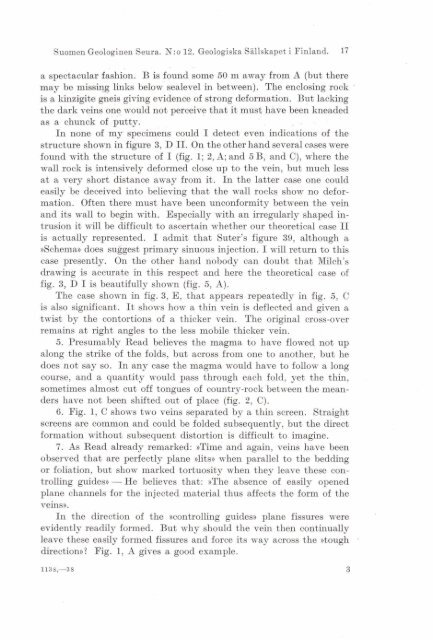GOHMISSION GEOLOGIQVE - Arkisto.gsf.fi
GOHMISSION GEOLOGIQVE - Arkisto.gsf.fi
GOHMISSION GEOLOGIQVE - Arkisto.gsf.fi
You also want an ePaper? Increase the reach of your titles
YUMPU automatically turns print PDFs into web optimized ePapers that Google loves.
Suomen Geologinen Seura. N:o 12. Qeologiska Sallskapet i Finland. 17<br />
a spectacular fashion. B is found some 50 m away from A (but there<br />
may be missing links below sealevel in between). The enclosing rock '<br />
is a kinaigite gneis giving evidence of strong deformation. But lacking<br />
the dark ~eins one would not perceive that it must have been kneaded<br />
as a chunck of iutty.<br />
In none of my specimens could 1 detect even indications of the<br />
structure shown in <strong>fi</strong>gure 3, D II. On the other hand several ceaes were<br />
found with the structure of 1 (<strong>fi</strong>g. 1; 2,A; and 5 B, and C), where the<br />
wall rock is intensively deformed close up to the vein, but much less<br />
at a very short distance away from it. In the latter case one could<br />
easily be deceived into believing that the wa11 rocks show no deformation.<br />
Often there must have been unconformity between the vein<br />
and its wall to begin with. Especially with an irregularly shaped intrusion<br />
it will be dif<strong>fi</strong>cult to ascertain whether our theoretical case II<br />
is actuaily represented. 1 admit that Suter's <strong>fi</strong>gure 39, although a<br />
))Schema)) does suggest primary sinuous injection. 1 wilI return to this<br />
case presently. On the other hand nobody can doubt that Milch's<br />
drawing is accurate in this respeot and here the theoretical case of<br />
<strong>fi</strong>g. 3, D 1 is beautifully shown (<strong>fi</strong>g. 5, A).<br />
The case shown in <strong>fi</strong>g. 3, E, that appears repeatedly in <strong>fi</strong>g. 5, C<br />
is also signi<strong>fi</strong>cant. It shows how a thin vein is deflected and given a<br />
twist by the contortions of a thicker vein. The original cross-over<br />
remaim at right angles to the less mobile thicker vein.<br />
5. Presumably Read believes the magma to have flowed not up<br />
along the strike of the folds, but across from one to another, but he<br />
does not say so. In any case the magrna would have to follow a long<br />
course, and a quantity would pass through each fold, yet the thin,<br />
sometimes almost cut off tongues of country-rock between the meanders<br />
have not been shifted out of place (<strong>fi</strong>g. 2, C).<br />
6. Fig. 1, C shows two veina separated by a thin screen. Straight<br />
screens are common and could be folded subsequently, but the direct<br />
formation without subsequent distortioIi is dif<strong>fi</strong>cult to irnagine.<br />
7. As Read already remarked: >>Time and again, veins have been<br />
observed that are perfectly plane ))lits>) when parallel to the bedding<br />
or foliation, but show marked tortuosity when they leave these controlling<br />
guideso - He believes that: ))The absence of easily opened<br />
plane channels for the injected materia1 thus affects the form of the<br />
veins)).<br />
In the direction of the ))controlling guideso plane <strong>fi</strong>ssures were<br />
evidently readily formed. But why should the vein then continually<br />
leave these easily formed <strong>fi</strong>ssures and force its way across the ~tough .<br />
directionv? Fig. 1, A gives a good example.
















